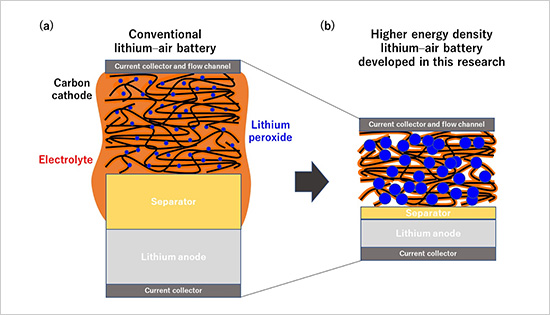Identification of a Major Factor Influencing the Cycle Life of Practical Li-O2 Batteries
—Optimizing the Balance between Electrolyte Volume and Electrode Areal Capacity May Be the Key to the Development of Practical Batteries—
2020.12.02
National Institute for Materials Science (NIMS)
Japan Science and Technology Agency (JST)
SoftBank Corp.
NIMS and SoftBank discovered that the cycle life of high energy density lithium-air batteries is predominantly influenced by the ratio of electrolyte volume to electrode areal capacity.
Abstract
- NIMS and SoftBank discovered that the cycle life of high energy density lithium-air batteries is predominantly influenced by the ratio of electrolyte volume to electrode areal capacity. The team developed a technique to quantify side reaction products formed and oxygen used in battery electrochemical reactions. Using this technique, the team was able to precisely assess the overall balance between reactants and products, leading to this discovery. These results may facilitate R&D concerning practical lithium-air batteries.
- Lithium-air batteries have potential to develop into the ultimate rechargeable batteries: they are lightweight and have high energy capacity and their theoretical energy density is several times the energy density of current lithium-ion batteries. Because of these potential advantages, they are anticipated to be applicable to a wide range of technologies, such as drones, electric vehicles and household electricity storage systems. The NIMS-SoftBank Advanced Technologies Development Center, established in 2018, has been carrying out lithium-air battery research to achieve the practical use of this battery in various technologies, including mobile phone base stations, the internet of things and HAPS (high altitude platform stations). Extending battery cycle life is particularly important for these purposes. Most evaluations of lithium-air battery cycle life had focused on assessment of individual battery components, such as electrode materials, and only a few studies have taken an approach of actually fabricating functional high energy density lithium-air batteries and evaluating their cycle lives. In addition, only a few methods for quantitively measuring substances involved in battery electrochemical reactions (e.g., oxygen used as the cathode active material and gaseous by-products) were available. Because of these limitations, overall balance between reactants and products was impossible to measure, making it difficult to identify primary factors influencing battery cycle life and slowing research and development of practical lithium-air batteries.
- This research team recently developed a technique capable of quantifying oxygen used in electrochemical reactions and gases and volatile substances produced during charge and discharge cycles. The team then used this technique to precisely analyze complex electrochemical reactions occurring in high energy density lithium-air batteries developed by the NIMS-SoftBank Advanced Technologies Development Center. As a result, the team found for the first time that the cycle lives of lithium-air batteries are predominantly influenced by the ratio of electrolyte volume to electrode areal capacity. This means that battery cycle life can be extended by decreasing the areal capacity of the electrode while maintaining the volume of the electrolyte constant. However, decreasing electrode areal capacity will also cause the energy density of the battery to decrease. The development of practical lithium-air batteries will therefore require optimization of the ratio parameter during the process of designing batteries and evaluating battery materials.
- In future research, we intend to develop methods for reducing the amounts of by-products produced by electrochemical reactions in batteries, thereby accelerating the efforts of the NIMS-SoftBank Advanced Technologies Development Center to put lithium-air batteries into practical use.
- This project was carried out by the research team led by Makoto Ue (Special Researcher, Center for Green Research on Energy and Environmental Materials (C4GR), NIMS; relocated in October 2020), Hitoshi Asahina (Engineer, C4GR, NIMS), Shoichi Matsuda (Senior Researcher, C4GR, NIMS) and Kohei Uosaki (Fellow, C4GR, NIMS; also the Director of the NIMS-SoftBank Advanced Technologies Development Center). This work was mainly supported by 1) the Global Research Center for Environment and Energy based on Nanomaterials Science (GREEN), which was established under the MEXT Program for Integrated Materials Development, 2) the JST ALCA-SPRING program (ALCA: Advanced Low Carbon Technology Research and Development Program, SPRING: Specially Promoted Research for Innovative Next Generation Batteries) and 3) the NIMS-SoftBank Advanced Technologies Development Center.
- This research was published in RSC Advances, an online journal, at 2:00 am on December 2, 2020, Japan Time.

Figure 1. Schematic diagrams of an existing Li-O2 battery and the higher energy density Li-O2 battery developed in this research
Related files
- Center for Green Research on Energy and Environmental Materials
Contact information
(Regarding this research)
-
Shoichi Matsuda
Senior Researcher
Rechargeable Battery Materials Group
Center for Green research on Energy and Environmental Materials
National Institute for Materials Science
Tel: +81-29-860-4637
E-Mail: MATSUDA.Shoichi=nims.go.jp
(Please change "=" to "@")
(Regarding JST programs)
-
Masaru Oya
Department of R&D for Future Creation
Japan Science and Technology Agency
K's Gobancho, 7 Gobancho, Chiyoda-ku, Tokyo 102-0076, Japan
Tel: +81-3-3512-3543
E-Mail: alca=jst.go.jp
(Please change "=" to "@")
(General information)
-
Public Relations Office
National Institute for Materials Science
Tel: +81-29-859-2026
Fax: +81-29-859-2017
E-Mail: pressrelease=ml.nims.go.jp
(Please change "=" to "@") -
Public Relations Division
Japan Science and Technology Agency
5-3 Yonbancho, Chiyoda-ku, Tokyo 102-8666, Japan
Tel: +81-3-5214-8404
Fax: +81-3-5214-8432
E-Mail: jstkoho=jst.go.jp
(Please change "=" to "@")
Same Keywords
-
Development of a Lithium-Air Battery with an Energy Density over 500 Wh/kg
(lithium-air battery,battery,energy density)
2021.12.15
-
Chemical Crossover Accelerates Degradation of Lithium Electrode in High Energy Density Rechargeable Lithium–Oxygen Batteries
(SoftBank,cycle life)
2023.01.31
-
Estimation of Technology Level Required for Low-Cost Renewable Hydrogen Production
(battery,rechargeable)
2018.12.13
Recent Press Release
-
Simultaneous Imaging of Intracellular DNA and RNA Using Harmless Light
2025.10.27
-
Development of an AI Device Using Ion Gel and Graphene That Dramatically Streamlines Machine Learning Computations
2025.10.14
-
Demonstrating a Novel Method to Modulate Heat Flow Through the Collective Motion of Spins
2025.10.06
